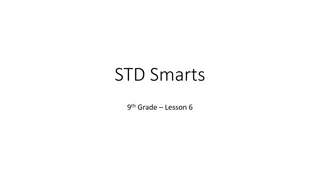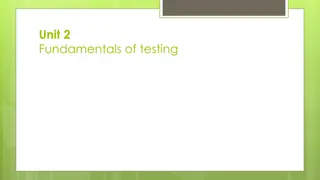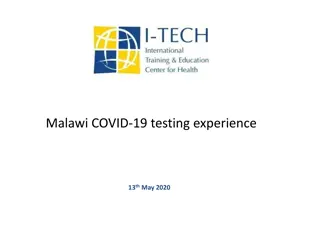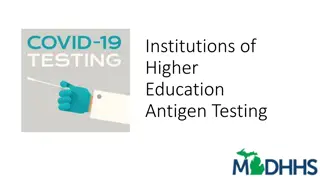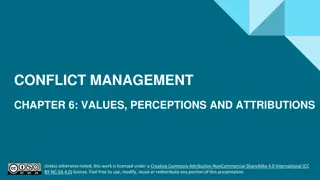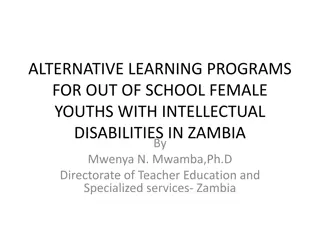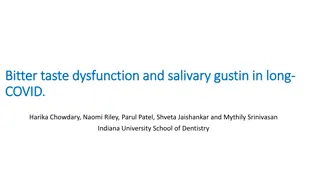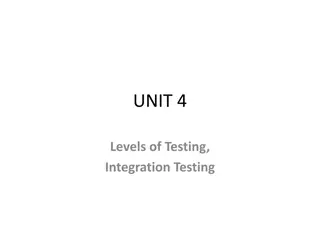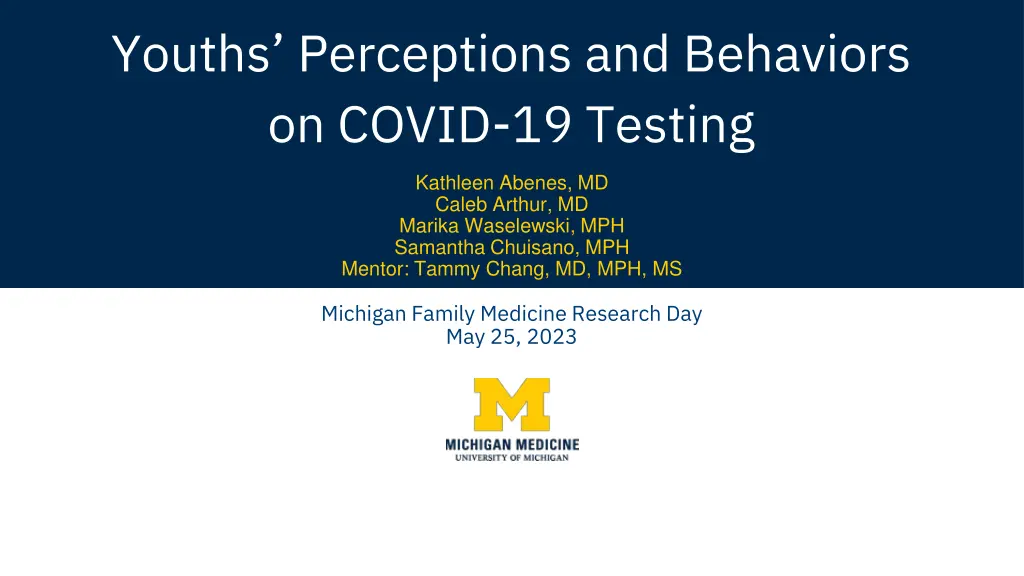
Insights into Youth Perceptions and Behaviors on COVID-19 Testing
Explore the study on how youths perceive and act towards COVID-19 testing before and after social gatherings. The MyVoice methodology gathers insights from 14-24-year-olds through text messaging polls, shedding light on their testing behaviors and preferences regarding free self-tests.
Download Presentation

Please find below an Image/Link to download the presentation.
The content on the website is provided AS IS for your information and personal use only. It may not be sold, licensed, or shared on other websites without obtaining consent from the author. If you encounter any issues during the download, it is possible that the publisher has removed the file from their server.
You are allowed to download the files provided on this website for personal or commercial use, subject to the condition that they are used lawfully. All files are the property of their respective owners.
The content on the website is provided AS IS for your information and personal use only. It may not be sold, licensed, or shared on other websites without obtaining consent from the author.
E N D
Presentation Transcript
Youths Perceptions and Behaviors on COVID-19 Testing Kathleen Abenes, MD Caleb Arthur, MD Marika Waselewski, MPH Samantha Chuisano, MPH Mentor: Tammy Chang, MD, MPH, MS Michigan Family Medicine Research Day May 25, 2023
Disclosures We have no financial disclosures This work has been submitted for publication
Introduction Social gatherings are frequent sources of COVID-19 infections, including among youth Youth age 14-24 years represent >14% of our population, yet little is known about their COVID testing behaviors before and after gatherings CDC recommends testing to reduce spread of COVID if an individual has symptoms of COVID-19 at least five days after close exposure to an individual with COVID-19, even without symptoms Home PCR and antigen COVID testing are accessible options
AGENDA PURPOSE To assess the behaviors and perceptions of youth related to testing for COVID-19 before and/or after social gatherings to inform efforts to reduce disease spread.
MyVoice is a weekly interactive text messaging poll that empowers adolescents and young adults to voice their opinion on salient issues.
MyVoice Methodology Youth participants age 14-24 years Recruitment via social media Facebook, Instagram, YouTube, Tiktok, etc Include marginalized or missing perspectives Participants earn $1 per week to answer text message polls Rapid data collection and analysis Prompt dissemination to stakeholders
Methods Five open-ended questions were texted to youth ages 14-24 throughout the United States Survey was sent on November 19, 2021 Participants had 1 week to answer prior to download of data for analysis
What, if anything, would prompt you to get tested for COVID-19? Would you ever get tested for COVID-19 BEFORE a social gathering? Why? Would you ever get tested AFTER a social gathering? Why? Have you ever gotten tested for COVID-19? Why? Would access to free COVID-19 self-tests be helpful to you? Why or why not?
Data Analysis Open-ended text message response data Developed a codebook using inductive approach 2 independent coders Application of codes within each question Discrepancies were resolved via discussion Participant self-reported demographic data Collected at enrollment in MyVoice cohort Code frequency and demographic data were summarized using descriptive statistics
Table 1: Respondent demographic characteristics (n=989) Participants n(%) or mean (SD) 20.2 +/- 2.4 Age Gender Male Female Other gender identity Race and ethnicity Non-Hispanic White Hispanic Non-Hispanic Black Non-Hispanic other Education level Less than high school High school graduate Some college or technical school Associate s or technical degree Bachelor s degree or higher Region Midwest Northeast South West Rurality Rural Suburban Urban 562 (56.8) 336 (34.0) 91 (9.2) Of 1204 participants, 989 responded to at least one survey question 661 (67.0) 92 (9.3) 62 (6.3) 172 (17.4) Average age 20.2 2.4 with range 15-24 years. 221 (22.4) 134 (13.6) 425 (43.0) 106 (10.7) 103 (10.4) Most respondents identified as male (56.8%) and non-Hispanic white (67.0%) Many completed some college or technical school at the time of the survey (43.0%) 284 (28.7) 209 (21.2) 274 (27.7) 221 (22.4) Most lived in a suburban setting (56.4%) 86 (8.6) 554 (56.4) 343 (34.9)
Results 81% reported testing for COVID-19 at least once 71% reported they would test following an event 51% they would test before an event Of youth who would not get tested, being vaccinated was the most reported reason for not testing.
Would you ever get tested for COVID-19 BEFORE a social gathering? Why? (n=958) "Yes to make sure I don't transmit it to a large group" "No, because I feel fine and don't have a fever" Yes 50.8% No 30.8% "I don't think so because spreading as a vaccinated individual without symptoms isn't very common "Yes if I need to show a negative result before attending."
Would you ever get tested for COVID-19 AFTER a social gathering? Why? (n=931) "Yes if someone who was there has tested positive" "No, because I am vaccinated." No 15.7% Yes 70.6% "No, I have taken precautions during the gathering and therefore would not need it." "I would just to be safe "
Would access to free COVID-19 self-tests be helpful to you? Why or why not? (n=932) "Yes, it would be more convenient " "No, they do not work " No 21.4% Yes 67.5% "No because I can get free ones at school" "Yes because I don't have enough money to pay for them"
Discussion Vaccinations were cited as reasons against COVID testing, suggesting a trust in vaccines among youth CDC guidelines do not vary based on vaccine status AAP states vaccines should NOT guide testing Immunization does not eliminate the need for testing
Limitations Communication with youth was limited to text message Sample was large, but not representative of national demographics Not able to ask follow-up questions about youth behaviors after testing positive, which may more directly measure the impact of testing
Conclusions Youth are likely to test for COVID-19 following concern for exposure AFTER an event Less likely if they are vaccinated Desire to test is primarily driven by symptoms, exposures, and requirements Youth are interested in increased access to home testing Youth-centered communications regarding testing recommendations may reduce COVID-19 spread among youth
References Centers for Disease Control and Prevention. COVID-19 Testing: What You Need to Know. Available from: https://www.cdc.gov/coronavirus/2019-ncov/symptoms- testing/testing.html Accessed September 21, 2022. U.S. Department of Health & Human Services. Community-Based Testing Sites for COVID-19. Available from: https://www.hhs.gov/coronavirus/community-based-testing- sites/index.html Accessed September 21, 2022. State of Michigan. Insurance Coverage for Over-the-Counter COVID-19 Tests. Available from: https://www.michigan.gov/difs/covid-19/insurance-coverage-for-over-the- counter-covid-19-tests Accessed September 21, 2022. United States Postal Service. At-Home COVID-19 Tests. Available from: https://faq.usps.com/s/article/At-Home-COVID-19-Test-KitsAccessed September 21, 2022. Centers for Disease Control and Prevention. COVID-19 by County. Available from: https://www.cdc.gov/coronavirus/2019-ncov/your-health/covid-by-county.html Accessed September 21, 2022. Centers for Disease Control and Prevention. Testing Overview. Available from: https://www.cdc.gov/coronavirus/2019-ncov/hcp/testing-overview.html#previous Accessed September 21, 2022. American Academy of Pediatrics. COVID-19 Testing Guidance. Available from: https://www.aap.org/en/pages/2019-novel-coronavirus-covid-19-infections/clinical- guidance/covid-19-testing-guidance/ Accessed August 21, 2022. Virginia Department of Health. Protect Your Health. What to do if you were exposed to COVID-19? Available from: https://www.vdh.virginia.gov/coronavirus/protect- yourself/exposure/ Accessed September 21, 2022. Bogg T, Milad E. Demographic, personality, and social cognition correlates of coronavirus guideline adherence in a US sample. Health Psychology. 2020;39(12):1026. Bailey B, Whelen ML, Strunk DR. Adhering to COVID 19 health guidelines: Examining demographic and psychological predictors of adherence. Appl Psychol Health Well Being. 2021;13(4):968-985. Rusou Z, Diamant I. Adhering to COVID-19 health guidelines: A behavioral-failure perspective. Front Psychol. 2022;13:916960. United States Census Bureau. United States Population by Age and Sex. Available from: https://www.census.gov/popclock/data_tables.php?component=pyramid Accessed September 21, 2022. American Academy of Pediatrics. Jenco M. Young people play vital role in stopping spread of COVID-19. Available from: https://publications.aap.org/aapnews/news/15039?autologincheck=redirected?nfToken=00000000-0000-0000-0000-000000000000Accessed September 21, 2022.
References World Health Organization. Coronavirus disease (COVID-19): Adolescents and youth. Available from: https://www.who.int/news-room/questions-and- answers/item/coronavirus-disease-covid-19-adolescents-and-youth Accessed September 21, 2022. My Voice. Transparency Initiative. Available from: https://hearmyvoicenow.org/research/transparency/ Accessed September 21, 2022 DeJonckheere M, Nichols LP, Moniz MH, et al. MyVoice national text message survey of youth aged 14 to 24 years: study protocol. JMIR research protocols. 2017;6(12):e8502. Babchuk WA. Fundamentals of qualitative analysis in family medicine. Fam Med Community Health. 2019;7(2): e000040 Centers for Disease Control and Prevention. COVID Data Tracker. Available from: https://covid.cdc.gov/covid-data-tracker/#rates-by-vaccine-status Accessed September 21, 2022. Vitiello A, Ferrara F, Troiano V, La Porta R. COVID-19 vaccines and decreased transmission of SARS-CoV-2. Inflammopharmacology. 2021;29(5):1357-1360. Cevik M, Bogoch, II, Carson G, D'Ortenzio E, Kuppalli K. Prevalence of Asymptomatic SARS-CoV-2 Infection. Ann Intern Med. Feb 2021;174(2):283-284. doi:10.7326/l20-1283 Centers for Disease Control and Prevention. Trends in Number of COVID-19 Cases and Deaths in the US Reported to CDC, by State/Territory. Available from: https://covid.cdc.gov/covid-data-tracker/#trends_dailycases Accessed September 21, 2022. Centers for Disease Control and Prevention. Trends in Number of COVID-19 Vaccinations in the US. Available from: https://covid.cdc.gov/covid-data-tracker/#vaccination-trends Accessed September 29, 2022. National Center for Education Statistics. Immediate College Enrollment Rate. Available from: https://nces.ed.gov/programs/coe/indicator/cpa#suggested-citation Accessed September 21, 2022. U.S. Bureau of Labor Statistics. Employed persons by detailed occupation and age. Available from: https://www.bls.gov/cps/cpsaat11b.pdf Accessed September 21, 2022. The White House. Fact Sheet: The Biden Administration Announces Americans Can Order Additional Free At-Home, Rapid COVID-19 Tests at COVIDTests.gov. Available from: https://www.whitehouse.gov/briefing-room/statements-releases/2022/05/17/fact-sheet-the-biden-administration-announces-americans-can-order-additional-free-at-home- rapid-covid-19-tests-at-covidtests-gov/ Accessed September 21, 2022. State of Michigan. MI Backpack Home Test Program. Available from: https://www.michigan.gov/coronavirus/resources/k-12-school-opening-guidance/mi-safe-schools-testing- program/content/mi-backpack-home-test-pilot-program Accessed September 21, 2022.
Dr. Chang Dr. O Dwyer Marika Waselewski Katie Grode Sam Chuisano THANK YOU

